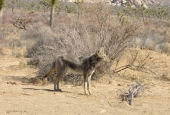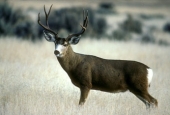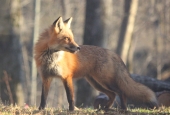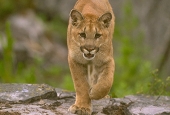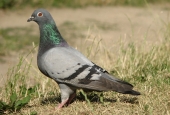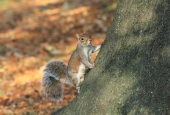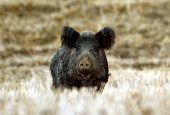Alameda County is seeing an increase in problems associated with wild turkeys. Turkeys are social birds with flocks of varying sizes. Adult male turkeys weigh up to 25 pounds and females can weigh up to10 pounds. They are not territorial but do defend an area against other turkeys of the same sex. The social behavior between younger and older turkeys may lead homeowners to perceive turkeys as a nuisance. They may become very aggressive to the homeowner.
It was believed that turkeys cause a great deal of agricultural damage, but a closer review has shown that their effect was minimal. They are opportunistic feeders. In the spring and summer they feed on grass, seeds, berries, and insects. In the fall and winter they feed mainly on nuts, seeds, and grains. They prefer to live close to a wooded area and open landscape or crop fields, but are increasingly moving into suburban environments. Turkeys also look for roosting sites. These sites are usually in large trees. Because of their size and large accumulation of fecal droppings, significant damage to personal property, especially vehicles, can occur.
If a resident is experiencing problems with turkeys it is strongly recommended that they call the district so a Vector Control Biologist and Wildlife Specialist can investigate the nuisance wildlife issue. The District Team will determine what prevention and exclusion methods would be most successful in removing the turkeys from the property.
Learn more about Wild Turkeys
Alameda County is seeing a growing problem with wild pigs. Across the county wild pigs are causing serious damage to the environment. Their activity impacts the water quality of streams and their rooting, wallowing and trampling is damaging forest and agricultural soils and causes the spread of invasive plant species. Wild pigs also compete with our local deer and turkey populations for food and shelter and are serious predators on eggs of ground nesting birds.
Wild pigs are black or dark brown, and males (boars) may grow to over 200 pounds with females reaching 150 pounds. Ancestry and food availability will influence the size of the wild pigs and their population size. They tolerate a wide temperature range and different climates and eat almost anything, making them opportunistic omnivores. They can reproduce rapidly and have very few predators, so their numbers can lead to widespread populations.
If the resident is experiencing problems with feral pigs it is strongly recommended that they call the district so that a Vector Control Biologist and our Wildlife Specialist can investigate the nuisance wildlife issue. The District Team will determine what prevention and exclusion methods would be most successful in removing the feral pigs from the property.
Learn more about Wild Pigs
Pigeons are incredibly complex and intelligent animals with outstanding navigational abilities. They are sociable, and typically are a part of a flocks of 20-30 birds. Pigeons mate for life and tend to raise two chicks at the same time. Both adults share responsibility for caring for the young and both will incubate the eggs. Pigeons do transmit a number of infectious diseases including histoplasmosis, Cryptococcosis, Psittacosis, and toxoplasmosis. They can cause serious damage to properties with their droppings.
If the resident is experiencing problems with birds (pigeons) it is strongly recommended that they call the district so that a Vector Control Biologist and Wildlife Specialist can come and investigate the nuisance wildlife issue. The District Team will determine what prevention and exclusion methods would be most successful in removing the birds (pigeons) from the property.
Alameda County is seeing a growing population of black-tail deer. In our urban areas, deer can cause extensive damage by feeding on plants around homes and their gardens.
If the resident is experiencing problems with deer it is strongly recommended that they call the district so that a Vector Control Biologist and Wildlife Specialist can investigate the nuisance wildlife issue. The District Team will determine what prevention and exclusion methods would be most successful in removing the deer from the property.
Learn more about Deer
If the resident is experiencing problems with coyotes it is strongly recommended that they call the district so that a Vector Control Biologist and Wildlife Specialist can investigate the nuisance wildlife issue. The District Team will determine what prevention and exclusion methods would be most successful in removing the coyotes from the property.
Learn more about Coyotes
If a resident is experiencing problems with a mountain lion it is strongly recommended that they call the district so a Vector Control Biologist and Wildlife Specialist can come and investigate the nuisance wildlife issue. The District Team will determine what prevention and exclusion methods would be most successful in removing the mountain lions from the property.
Learn more about Mountain Lions
If the resident is experiencing problems with tree squirrels it is strongly recommended that they call the district so that a Vector Control Biologist and our Wildlife Specialist can investigate the nuisance wildlife issue. The District Team will determine what prevention and exclusion methods would be most successful in removing the tree squirrels from the property.
Learn more about Tree Squirrels
If the resident is experiencing problems with foxes it is strongly recommended that they call the district so that a Vector Control Biologist and our Wildlife Specialist can investigate the nuisance wildlife issue. The District Team will determine what prevention and exclusion methods would be most successful in removing the foxes from the property.
Learn more about Foxes



